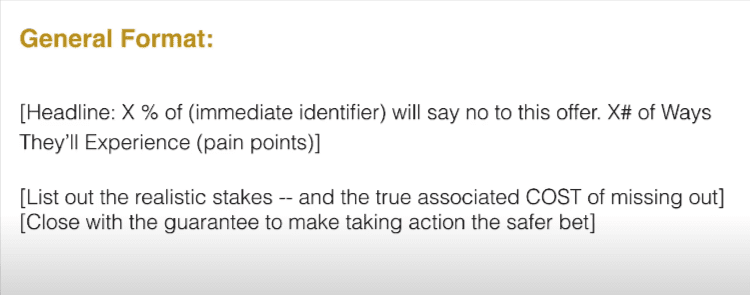STEP 1: Master the Fundamentals of the Risk Mitigator Close
Welcome to a fundamental strategy in the art of closing deals: the Risk Mitigator Close. This approach focuses on striking a delicate balance between outlining the genuine, non-exaggerated risks of inaction and contrasting those with a reassuring guarantee that opting in is the safer, more beneficial choice. Achieving this balance will empower you to make a compelling argument that effectively encourages your prospects to move forward.

At its core, the Risk Mitigator is perhaps the most challenging technique within our closes set due to its confrontational nature. It necessitates a level of finesse and strategic language choice. Here, you'll learn to leverage “they language” as opposed to “you language,” a method that not only softens the approach but also creates a sense of exclusivity and empowerment for the reader. By positioning the prospect as separate from those who will face negative consequences through inaction, you enhance the appeal of your offer, making it an exclusive opportunity to avoid common pitfalls.

STEP 2: Construct Your Risk Mitigator Close with Precision

Step 2.1: Craft an Impactful Headline
Begin with a headline that highlights a percentage of a specific group who are likely to ignore the offer, setting the stage for the consequences of such a decision.
Example:
“75% of entrepreneurs, executives, and business leaders reading this will mull it over, bury this page in a Chrome tab, and forget all about it as the enrollment period closes.”
Step 2.2: Highlight Pain Points and Consequences
List realistic stakes and the true associated costs of inaction, emphasizing the pain points directly.
Example:
“Here are three ways they'll continue to flirt with burnout, stalled momentum as team members underperform, jump ship, and leave them to plug the gaps with even more hustle.”
Step 2.3: Detail Pain Points Specifically
Delve into each pain point with specifics, including the true cost of such outcomes.
Examples include:
- Missing critical talent and functional gaps, leading to straightjacketed momentum and significant well-being costs.
- Inefficient hiring decisions, resulting in financial losses.
- Gaps in the onboarding process, affecting the company's growth capacity.
Step 2.4: Apply a Strong Risk Reversal
Conclude the close with a strong, reassuring guarantee that choosing to engage with your offer is a safe and advantageous decision.
Example:
“But with 30 risk-free days to work the system, wouldn't you rather see what it's like to become indestructible?”
STEP 3: Reinforce the Prospect's Aspirations
The final paragraph should reinvigorate the prospect's aspirations and urge them towards action, reminding them of their achievements so far and the greater heights they can reach with this new partnership.
Example:
“This is your invitation to partner with us for the next 12 weeks to design your team for scale, empower them to generate quicker, more predictable ROI, and lead them towards rapid scale and record-breaking performance.”
STEP 4: Practice and Implement the Risk Mitigator Close
Encourage the reader to practice writing a Risk Mitigator Close for their own sales page, promising further alternative closing techniques in subsequent lessons. This iterative learning process will not only refine their closing skills but also equip them with versatile approaches to securing commitments.
STEP 5: Reflect on the Learning and Prepare for Future Closes
Mastering the Risk Mitigator Close requires patience, practice, and precision. By understanding the stakes involved in your prospect's decision-making process and offering a safe, empowering alternative, you can significantly increase your success rate in closing deals. Remember, the goal is to guide them towards realizing the greater risk lies in inaction, making your offer the clear, beneficial choice.
Stay tuned for our next lesson, where we'll explore the Minimum Viable Commitment and the Quickest, Most Valuable Win Challenge, further expanding your repertoire of effective closing techniques.

